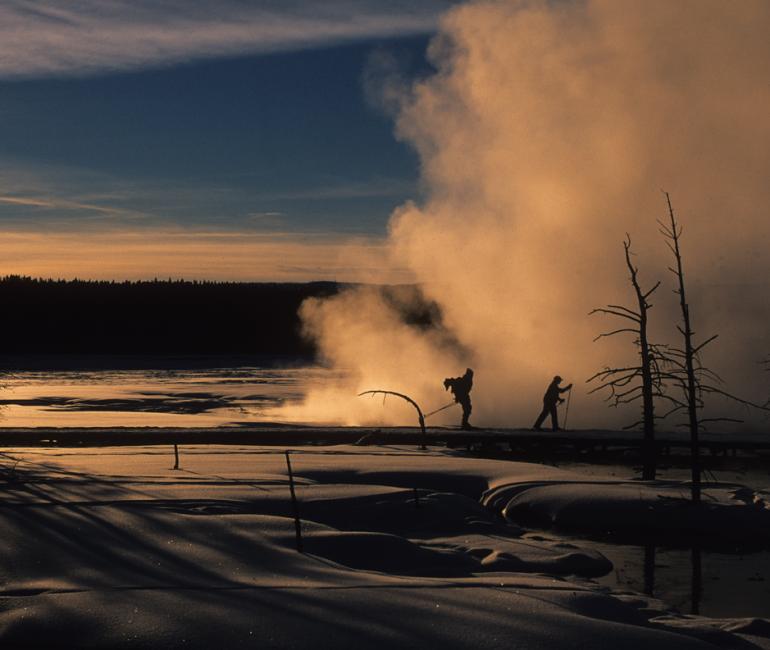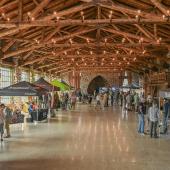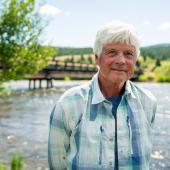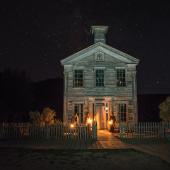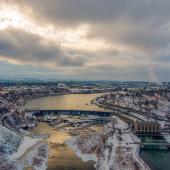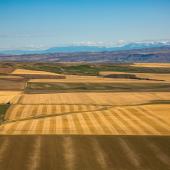Seasons of Change
Every year West Yellowstone welcomes winter visitors from throughout the county and around the world. They will come, as they do each winter, to see timeless wonders of nature, such as Old Faithful geyser, the Grand Canyon of the Yellowstone, wolves (if they are lucky), and certainly the primal scenes of bison wandering amid columns of steam and snow-laden trees.
Yet for all its continuity, Yellowstone National Park has witnessed plenty of change—nowhere more than in its winter season. In West Yellowstone, the most popular gateway to the world’s first national park and one of the world's foremost snowmobiling destinations, more visitors now arrive with cross-country skis, snowshoes, cameras, and spotting scopes, and they have a greater desire to learn about the Park, to be a part of its protection.
Shifting Snow beneath Our Feet
In a way, the changes have been a long time coming. A series of back-and-forth rulings over snowmobile restrictions in the Park have created as much controversy as they have uncertainty among tourists about what they're allowed and not allowed to do. Visits via snowmobile have significantly declined as a result. From December 2008 to March 2009, for example, the National Park Service reported that 13,985 visitors entered the Park through the West entrance via snowmobile; that was about 26% lower than a year earlier.
As the times changed and visitors increasingly demanded certain things that we were not providing, the last decade has presented West Yellowstone and my fellow tour operators and business owners with a series of significant challenges. One challenge—and opportunity for West Yellowstone, as it turns out—has simply been demographic. For tens of millions of Baby Boomers, exercise has become a quality-of-life issue. Wanting to be more physically active and interactive with the outdoors, these Boomers are part of the increasing number of winter visitors who arrive in West Yellowstone with skis and snowshoes, wanting a different, more active experience. To accommodate them, we are equipping more snowcoaches with ski racks. Some snowcoach operators have expanded their tour offerings to include ski and snowshoe outings.
Another shift in public demand has challenged not just West Yellowstone, but similar communities all over the nation that serve as gateways to unique natural places: visitors increasingly want more than simple access. They want to learn about these places and be assured that the way in which they are visiting is helping protect fragile resources for other visitors and for their children and grandchildren. That's why many visitors now seek out tour operators who make special efforts in visitor education and resource protection.
Here again, many West Yellowstone businesses have made huge investments and are providing new services to visitors. Modern snowcoaches and updated historic snowcoaches are helping to protect Yellowstone’s air quality and the remarkable quiet that is one of the Park’s most special winter qualities. Meanwhile, tour businesses have hired guides who work with the National Park Service’s outstanding interpretive staff to provide visitors with more information about Yellowstone’s wildlife, geology, and history.
Another major improvement—not finished, but well underway—is improved winter access for visitors who use wheelchairs. Last winter, Yellowstone’s first ADA-compliant snowcoach with a wheelchair lift went into use. West Yellowstone is also developing more reliable over-snow access into the Park, even for those times when snow does not adequately cover Yellowstone’s roads. Snowcoaches equipped with rubber tracks can dependably travel roads even in very light snow, ensuring that visitors who booked vacations well in advance and traveled great distances are able to access and enjoy the Park.
A New Future for West?
Five years ago, winter in West was snow machines zooming to and fro, everywhere, and the entire economy seemed to depend on visits from rotund Midwesterners in checkered coats who were looking to ride some four-bangers. Now, huge non-snowmobile-related events such as the Rendezvous ski race and the Yellowstone Ski Festival draw participants from around the world and even entice a growing number of professional athletes to live and train in West.
Though the future is unknown, visitors who come to West this winter will see a new chapter in this mountain town's continuing story—winter access that caters to the increasing desire of visitors to be physically active during their visits, learn about Yellowstone, and help with its stewardship. The real question, though, is whether West Yellowstone is following the lead of Bozeman and other New West towns that have undergone significant psychographic and demographic shifts in their populations. Is the old guard gone, demoted and doomed, or merely incurring another swing in the ongoing pendulum of snowmobile acceptance?
Randy Roberson and his wife Jeanine own and operate Yellowstone Vacations in West Yellowstone (yellowstonevacations.com). Randy moved to West in 1964, when he was nine years old.

